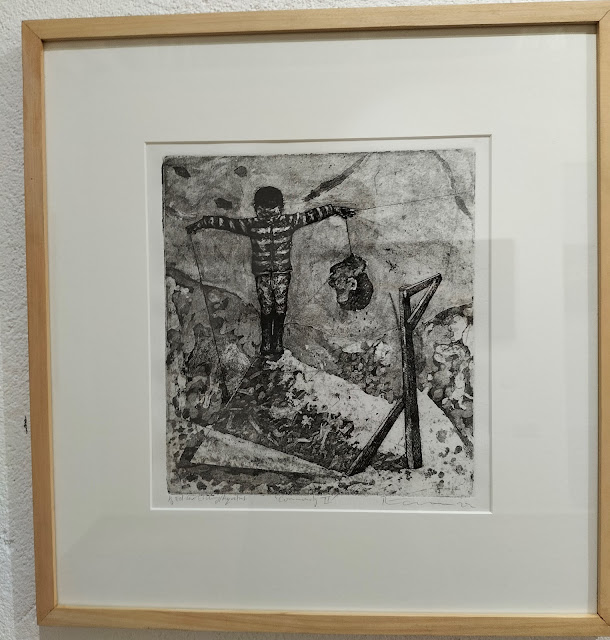PRINTS BY
THE PAINTERS AT ONE OFF
By
Margaretta wa Gacheru (Posted April 11, 2022)
Prints
present limitless possibilities to both their creators and the public at large.
For one,
they are easily re-printed, making them more affordable than an artist’s
original one-of-a-kind work. So, if someone wants a piece by a particular
artist but can’t afford what their one-off works are worth, that someone can be
quick to contemplate acquiring a print instead.
There is a
versatility to print-making that isn’t necessarily available in a painting.
Just look at Andy Warhol’s prints of Marilyn Monroe or his Campbell Soup cans.
Warhol repeated each of these images over and again in a single work. Yet each image
is slightly different for various reasons. On one hand, it could be due to the
actual print-making process in which each printed image was produced by hand. But
it could also be intentional on the part of the artist who may add different
colors to the same etching or woodcut print as James Mweu does at One Off
Gallery’s current Print show. Either way, it can be intriguing to see these
subtle differences emerge when they happen spontaneously.
“One reason
I like print-making is because there is always that element of surprise,” says
Peterson Kamwathi, one of the nine Kenyan printmakers currently exhibiting at
One Off in a show curated by fellow print-maker Thom Ogonga.
Peterson was
suggesting that between the time the artist puts his or her ink on the plate
and the moment when they see the outcome of the printing process, one never
knows what exactly their print will look like. That for him is a thrill, even
if he is only working in black and white as are his works at One Off.
It has to be
very different for an artist like Dennis Muraguri who prints with multiple
colors, each one of which must be applied and printed separately and precisely.
I assume that is why the sometimes sculptor asks for big bucks for his prints.
There is so much labor required to achieve the effect of a work like Ecko
UNLTD, Ongata Line Trans.
That
magnificent print serves as a sort of centre piece for the whole prints show,
given that it’s the largest, most colorful and has the pride of placement at
the entrance into OneOff’s Stables gallery.
Muraguri’s Ongata
Line Trans may be a print, but it’s unlikely that there will be many
editions of it, given there is so much labor and detailed precision involved in
creating such a print masterpiece.
Yet every
print is different, as one will see at One Off where one will find all sorts of
prints. You’ll see etchings and aquatints (by Kamwathi), etching and collage
(Mandy Bonnell), silkscreen prints, (Wanjohi Maina), relief prints (James Mweu),
collagraphs (Patrick Karanja), and woodcuts carved on MDF board (Thom Ogonga,
Mari Endo, Dennis Muraguri, and Abdul Kipruto) which is slightly different in
effect from an actual woodcut.
The quality
of paper and the kind of ink involved in the process also make a different to a
print’s look. For instance, Muraguri and Ogonga both used process ink to
prepare their prints while Mari Endo used Japanese ink. And as for paper,
Wanjohi Maina worked with embossed paper while Mari with Mulberry paper.
Meanwhile, Abdul Kipruto used neither paper nor ink since what he’s brought for
the exhibition was his carved MDF board, a woodcut plate entitled ‘Bow 1’.
Abdul is not the only artist who is displaying more than just prints. Several others, including Muraguri, Ogongo, and James Mweu are also selling the plates they carved to create the prints that are for sale. To me, that seems like a major sacrifice since the beauty of creating the plate is that it serves as the key to creating a few or many more prints.
Abdul KiprutoThe plates
are like incised sculptures, each one being precious and practical to keep. I
suppose that by selling the plates, all the prints produced before a plate was
sold will be more valuable.
Otherwise,
prints are tricky. As long as an artist holds on to his/her plates, they can
sell more prints, making what the buyer once thought was a limited-edition
could become a common image splashed all over the internet.
In fact, in
this age of social media, it is virtually impossible to claim exclusivity to
images that one can easily find on Instagram, Twitter, or Facebook. Still, to
have a print of one’s own is still valuable if it was bought because you like
its look, not if you saw it as a prospective investment.







No comments:
Post a Comment